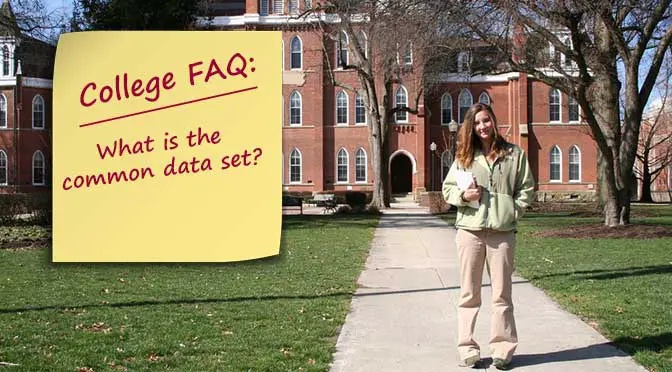 Whenever you search for colleges using the College Board, College Data, or US News & World Report, you are using data based on the common data set (CDS). This survey captures some information that isn’t available through the government’s Integrated Post-Secondary Education Data Set (IPEDS) used for the College Navigator search website and others.
Whenever you search for colleges using the College Board, College Data, or US News & World Report, you are using data based on the common data set (CDS). This survey captures some information that isn’t available through the government’s Integrated Post-Secondary Education Data Set (IPEDS) used for the College Navigator search website and others.
Why should you use the common data set?
Knowing what information can only be found in the common data set can save you time when you’re researching colleges. The following useful information only shows up on the CDS survey:
- Percentage of classes by size categories: this is more useful than average class size or the student to faculty ratio since it will allow you to see if the large classes outnumber the smaller ones.
- Average GPA of the freshman class: if you don’t have test scores to go by, GPA is another way to determine if the school is an academic fit.
- GPA-breakdown of freshman by high school GPA: again, like the class size breakdown, this provides you with more information than just an average does.
- Percent of freshman by SAT/ACT test score ranges: IPEDS will list average test scores but having the information broken down by categories will provide you with a better idea of how you match up to the freshman class.
- Percent of freshman by class rank: same reason as above.
- Percent of students who join a sorority or fraternity: the percentage of students involved in Greek life can have an impact on the overall campus culture.
- Percentage of students who have their institutionally defined financial aid need met: this information can help students looking for need based aid to target colleges.
- Number of students without need who receive merit awards: students with high EFCs can use this information to target colleges most likely to provide merit scholarships.
- Average merit award for student without need: this is critical information for those looking for merit because if the average is low, it may not significantly reduce the cost of attending the school.
- Information on aid to foreign students: this is the only source on the financial aid the institution provides to foreign students.
Some of this information will be readily available on the college search websites that use the common data set. The GPA and class size information is pretty common.
However, since each website decides which data to include, you won’t find the same information on all the websites. For example, the College Board’s Big Future website includes information on financial aid for international students but CollegeData does not. But CollegeData does include information on merit awards for non-need students.
How to Find the Common Data Set for a College
Therefore, depending on the information you’re looking for, it might be better if you just used the information directly from the common data set. Usually searching by the college name and “common data set” will locate the information. Over half of all 4-year colleges make their common data set available on their websites. Usually they’ll include the entire survey but some schools will leave out some sections. If the school doesn’t release the data on its own website, you can usually find the information on one of the college search websites mentioned previously.
Problems with the Common Data Set
The first problem with the common data set is that it may not be reliable. In the past US News College Rankings has used the IPEDS data to check CDS information that didn’t look right. The problem is that there is no way to check the information that is unique to the common data set. For example, if you go through the financial aid data, depending on the school it’s possible to calculate over 100% of students without need receiving merit aid.
Just a brief internet search will turn up instances of colleges providing inaccurate information in a bid to game US News College Rankings. Their only punishment is to be excluded from the rankings for a year. Colleges are legally required to report data to the federal government through the IPEDS system. Data is verified by the Department of Education before being published.
The common data set doesn’t include all of the information available through IPEDS. One is the average net price along with average net price by income categories. Other financial information unique to IPEDS is the average institution aid awarded along with the percentage of students receiving the aid.
Another thing to watch out for is the two sets using different definitions for the same category. One example is teaching assistants (TAs) or graduate assistants. If you look up Harvard University on the US News and World Report College Search site, you will see that the “Classes taught by graduate students” is listed as “N/A.” The fact is that the CDS excludes any graduate students by definition. You will find the following definition under section I- INSTRUCTIONAL FACULTY AND CLASS SIZE of the CDS instructions.
|
(d)undergraduate or graduate students who assist in the instruction of |
Exclude |
Exclude |
So even though Harvard reports through IPEDS 1,300 part-time instructional graduate assistants, they aren’t going to show up in the CDS or the sites that use them. Some universities do report “Classes Taught by Graduate Assistants” in the US News College Rankings but I’m not sure where they are actually reported in the Common Data Set form.
Another difference between the two data sets is the definition of gift aid. The CDS definition allows schools to count the entire subsidized federal loan as gift aid because the interest is subsidized. Gift aid under the IPEDS definition does not include any loans, subsidized or not.
Get a spreadsheet with all of the information you need to compare colleges
with the DIY College Rankings Spreadsheet



6 thoughts on “FAQ: What is the Common Data Set”